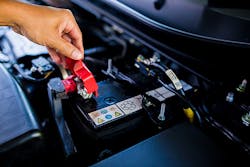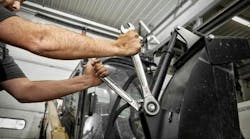Winter often means dead battery season. A customer might be cruising along with their battery getting the job done and things seem just fine. Then, the mercury drops, and suddenly their battery just can’t give their car what it needs any longer. Time for a new battery, so they bring it to the shop. You’ve got this… right? Well, maybe. As vehicle technology changes, even a task that used to be simple and straightforward just isn’t that easy any longer. But, armed with your trusty Booster Pac or Jump-N-Carry jump starter and a simple accessory, you can make this now complicated task more manageable.
Why do we say this task is more complicated than it used to be? Well, in the old days, the worst thing that could happen if you changed out a battery without taking precautionary steps was that you would lose your radio presets. This was a hassle, for sure, but didn’t impact vehicle operation. So, once the new battery was installed, you spent 3-4 minutes (tops) resetting your radio stations and you were good to go. Now, the radio presets are the least of your worries. On late-model vehicles, a wide variety of electronic components can lose stored settings, such as how the vehicle has adapted to your particular driving style. This can lead to erratic vehicle operation after the battery replacement as well as other electronic glitches that can be difficult to resolve.
One way to prevent these problems during a battery change is to utilize a memory saver to keep the vehicle powered throughout the swap. A memory saver is simply an auxiliary 12V battery connected to the system. They come in many shapes and sizes and can utilize different strategies for the vehicle connection. But, from our point of view, if you own a jump starter you already possess an auxiliary 12V battery. Now it is just a question of how to use it to interface with the vehicle.
For most vehicles, the simplest and most straightforward approach is to use a memory saver connector, such as our SOLAR ESA30, to create a connection from the jump starter’s 12V outlet to the vehicle’s OBD-II port. The beauty of this approach is that the OBD-II port is an always-on connection to the vehicle. In the early days of the jump starter, we recommended connecting via the vehicle’s 12V outlet, but about 20 years ago, most manufacturers changed their 12V outlet configurations such that they power down when the key is in the off position, which renders this method ineffective. So, we switched to the OBD-II port using the ESA30.
When connecting a jump starter for this purpose, using the ESA30, we recommend a specific connection sequence to ensure that your memory saver will effectively perform its task:
- Connect the ESA30 memory saver connector to the jump starter via the 12V outlet. Confirm a proper power connection by observing the LED light of the ESA30. A lit LED shows power is flowing.
- Disconnect the ESA30 from the jump starter.
- Connect the ESA30 memory saver connector to the vehicle via the OBD-II port. Confirm a proper power connection by observing the LED light of the ESA30. A lit LED shows power is flowing from the vehicle.
- Leaving the ESA30 connected to the vehicle, reconnect it to the jump starter via the 12V outlet. The LED on the ESA30 should still be lit.
- Now, you are ready to change out the vehicle battery.
- Once the new battery is installed, disconnect the jump starter from the vehicle.
Note: There are some things to remember when using the ESA30 to prevent unintended damage and other issues.
Remember that, when you change out the vehicle’s battery while using a memory saver, the vehicle’s electrical system is still live – that’s the whole point – and all usual care must be taken with the electrical system. To prevent a short circuit and loss of vehicle memory, do not allow the vehicle’s disconnected positive battery cable or the output cables from your jump starter to touch the vehicle ground.
Prior to connecting the memory saver, verify all vehicle accessories are OFF. To prevent overloading of a vehicle fuse or other vehicle damage, do not use the memory saver if the vehicle’s current draw is 4A or more when the vehicle is in a KEY OFF condition. Also, vehicle systems often cycle after the vehicle is turned off. Such cycling can place heavy demands on the vehicle’s electrical system. Before connecting the memory saver, turn the vehicle’s key to the OFF position and wait for 25 minutes. Doing so will ensure that all vehicle cycling is completed (on most vehicles).
Some vehicles, for reasons related to the warnings above, are not compatible with the use of a memory saver connector to connect a jump starter via the OBD-II port (BMW X5, some Volvo models, for example). Typically, these vehicles are higher-end vehicles with advanced electronics or sophisticated power-down routines. On these vehicles, you will often find starting points in the engine compartment (the battery is typically stored in an odd location), which are the manufacturer-preferred connection location for jump-starting. These starting points provide a great alternative to connecting via the OBD-II port, since, like the OBD-II port, they are typically always on and have the added benefit that they are designed to handle high power loads. When using this method, the jump starter positive cable is connected to the vehicle’s positive starting point and the jump starter negative cable is connected to the ground starting point (if available) or a standard engine or chassis ground.
Now, you’re done, right? Well, maybe. On many vehicles, yes, you are done. But, some vehicles require a battery reset after a new battery is installed. Check your owner’s manual for details related to this as it relates to your specific vehicle. Most late model BMW, VW, Audi, Porsche, Volvo, Jaguar, Land Rover, Ford, Nissan, and Infiniti vehicles have this requirement. You can typically get this reset done at your dealer, your trusted local mechanic, and many auto parts stores.
Taking these steps, using a tool you likely already possess, can make the difference between a quick, easy, and worry-free battery replacement and one that results in lingering problems in your electrical system.
Information provided by Clore Automotive


